
Grand Canyon Backpacking Trip -- November 17, 2015
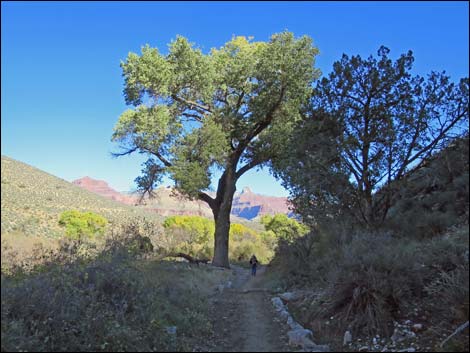 Cottonwood Tree along Bright Angel Trail |
Backpack Day 2. Tuesday -- Indian Garden to Phantom Ranch After a cold night with high, blustery winds and temperatures in the high 20s, the sun arrives late in deep side canyons on the south side of the Grand Canyon, and we were up and long gone from camp (9:30 AM) before it came up over the cliffs. A ways down the trail, however, we stopped for a few minutes to bask in the warn sunshine. At this elevation, the cottonwood trees were just starting to turn color, and after a day under the clouds, tree-fulls of bright yellow sun-lit leaves were striking. Scattered cottonwoods lined Garden Creek, and as we followed it downstream, the trail initially ran along sandstone ledges above the stream, putting us at eye-level with the yellow leaves. The stream channel slowly cut down through the Tapeats Sandstone, a cliff-forming layer of early to middle Cambrian age, and after crossing the Great Unconformity, we dropped into the wash and hopped across the stream a few times. Link to Map. |
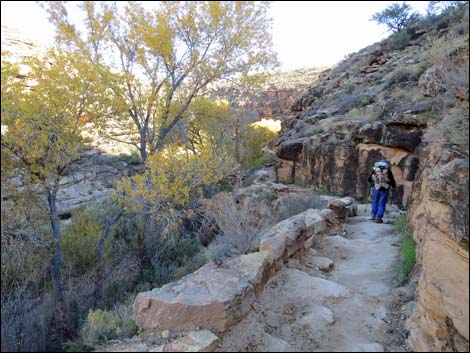 Bright Angel Trail following rocky ledges |
The Great Unconformity, a "non-layer," represents pages missing from the book of history in this area where about 1-billion years of history are missing. Not really missing, mountains once stood here, but over those billion years, the mountains eroded to form a flat plain. What we now see as the Vishnu Schist is the core of those old mountains, and as sea levels rose, the Tapeats Sandstone represents beach sand that washed along the ancient shoreline. Now in the Vishnu Schist, the "basement rock" of the Grand Canyon, our narrow Garden Creek Canyon opened abruptly onto the broad shoulder of a ridge. Here, atop the Devil's Corkscrew, Garden Creek falls away into a narrow canyon in a series of waterfalls, while the trail turns away from the creek to cut down and across cliffs where the trail was blasted out of the bedrock. |
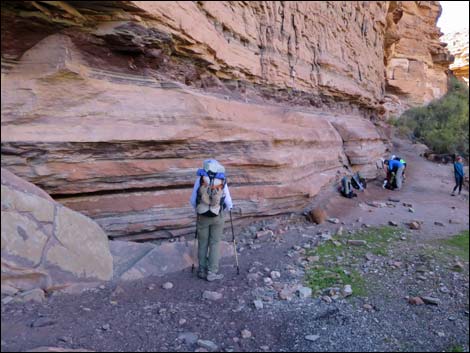 Liz at the Great Unconformity |
Near the top of the Devil's Corkscrew, the trail crosses two seeps where a few cottonwood trees cling to the cliff and shade rocky walls covered with marsh vegetation including ferns, mosses, and even orchids. Unfortunately, none of the flowers were blooming. In the Devil's Corkscrew, the trail winds down and around the head of a canyon ending in a series of switchbacks. Here, the summer sun reaches straight down to cook the rocks and produce an oven-effect for hapless mid-day hikers. For us, however, after passing the sunny seeps, we descended into deep winter shadows. Below the Devil's Corkscrew, the trail runs down Pipe Canyon at a moderate grade. Higher up, Pipe Creek ran as a trickle, but about a mile down canyon, Garden Creek cascaded down the cliffs and joined Pipe Creek. We hopped back and forth across the wider creek a few times, only dampening our boots a time or two. Pipe Canyon eventually narrows and sharply winds back and forth through S-curves making all of the canyon walls look the same until suddenly there was no canyon wall ahead, and we arrived on the bank of the Colorado River just after noon. |
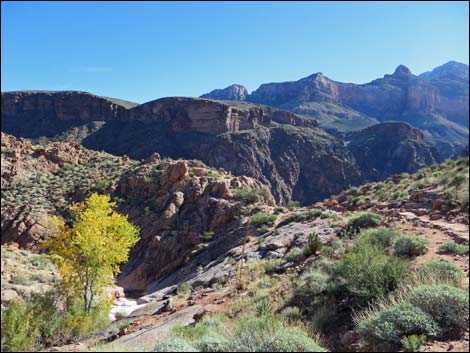 Garden Creek cascades into narrow canyon |
We stopped to celebrate our arrival at the bottom of the Grand Canyon by eating lunch and taking celebratory photos. It was a bucket-list item to get Liz to the bottom of the Grand Canyon, so technically we could check it off at that point, but we decided it made more sense to do the checking when we got back to the South Rim. The Bright Angel Trail technically ends here, and after lunch, we followed the River Trail east heading upstream along the Colorado. Along most of this section, the Vishnu cliffs drop straight into the river, so trail builders again took to blasting a trail into the cliffs. We were actually following the trace of a water pipe along here, which it turns out to be nice because the engineers made for gentle slopes and wide turns. We learned that all of the water on the South Rim comes from Roaring Springs, high on the North Rim. Water is piped down from the North Rim following the North Kaibab Trail, across the Colorado under a suspension bridge, down the River Trail, then up cliffs to Indian Garden (delivered to our campground water faucets), and finally up to the South Rim. |
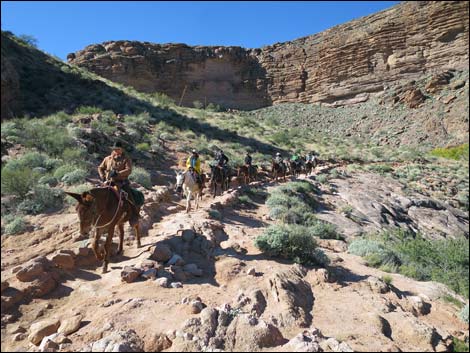 Mule trail coming down the trail |
Eventually the River Trail dropped to the banks of the Colorado and we crossed the river on the Silver Suspension Bridge to the north side. A few more yards upstream, and we turned up Bright Angel Canyon. The delta of Bright Angel Creek is broad and is used by the Park Service for mule corrals, ranger housing, and a waste treatment plant. A few minutes up Bright Angel Canyon, Bright Angel Campground begins on the west side of the creek. The canyon is narrow here, and designated campsites line the rock wall. About halfway along the campground, the trail passes restrooms with flush toilets, electric lights, and electrical outlets. Above there, the canyon is somewhat wider, and campsites line both sides of the trail. Campsites on the left lie up against the rock walls, and those on the right overlook Bright Angel Creek. Considering what little remained vacant, we were lucky to get the relatively isolated campsite against the cliffs just south of the toilets. |
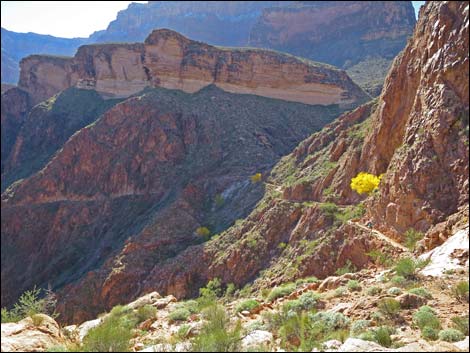 Top of Devil's Corkscrew |
We had heard that there had been a problem with the water pipeline, but the park website suggested that everything would be fixed a month before our arrival. Alas, this was not the case. Somewhere up the canyon, the pipe broke, and while water is flowing to the South Rim, they were having problems with the system in the Phantom area (Phantom Ranch Lodge and Bright Angel Campground), and the water was turned off. Camper water was available from a single faucet outside the dining room at Phantom Ranch, necessitating a 1/2-mile, round trip, hike from the campground. Of course, we could get water from the creek and treat it ourselves, but it was downstream from the Phantom Ranch mule barns and so not too inviting. At the restroom, the water was turned off, but the park service had stationed a 1,500-gallon firefighting water tank by the men's door, and everyone had to carry water in 5-gallon buckets from the water tank to pour into the toilet to effect a flush. It worked, but it was less the optimal. The people staying at the lodge for $140 per cabin per night had similar inconvenience with the toilets, but also suffered from lack of showers -- without an annoyance discount. |
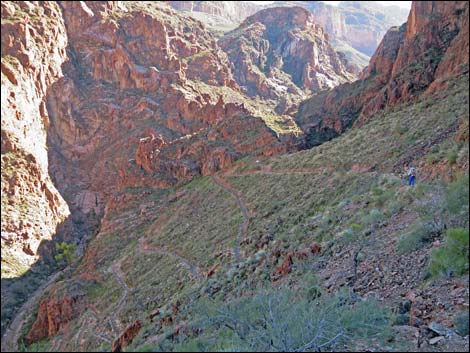 Middle of Devil's Corkscrew |
Perhaps the true motivation for the trip was the opportunity to see Ringtails (aka Ringtail cats) in the campground where some years ago they had become real pests for campers as they did everything they could to steal food. When Jim was there in 2006, a pack of Ringtails raided his campsite, but he woke up too late to see anything more than a black-and-white banded tail disappear into the bushes. We've looked for them elsewhere, and we've interacted with captive Ringtails, but we've never found them in the wild. As a result, Liz cooked a dinner that smelled good enough to bring in ringtails, but no such luck. We sat up late into the night hoping for nocturnal visitors, but alas, by 10 PM we gave up and went to bed. We never did see any ringtails, so we'll have to keep looking elsewhere. |
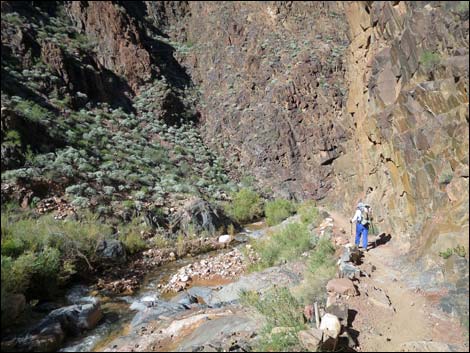 Bright Angel Trail along Pipe Creek |
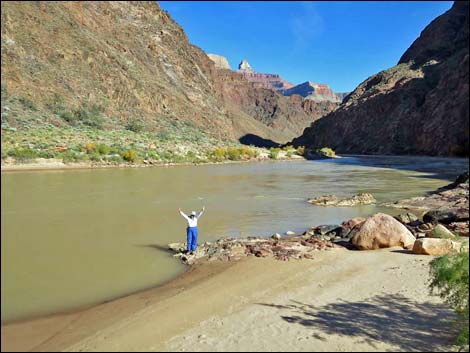 Liz in the bottom of the Grand Canyon |
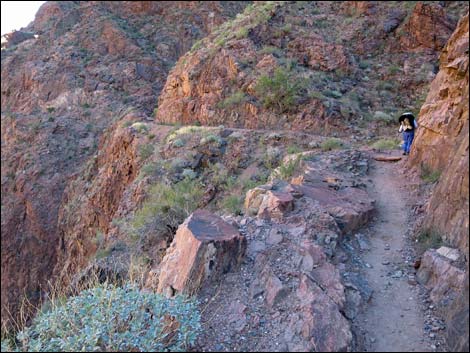 River Trail heading upstream |
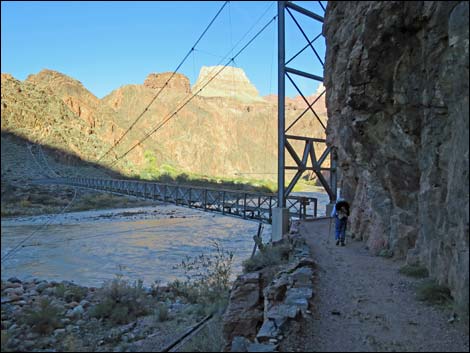 Silver Suspension Bridge |
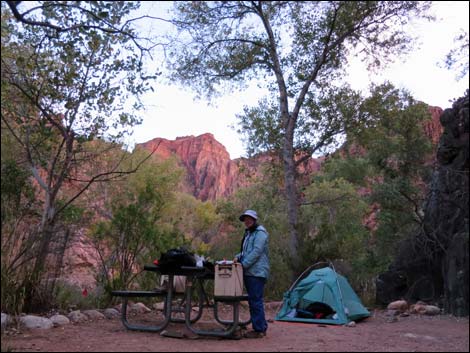 Campsite in Bright Angel Campground |
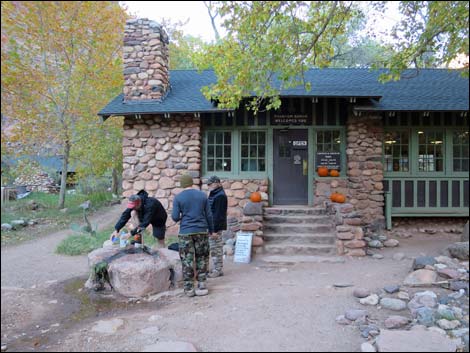 Phantom Ranch; camper water outside the Cantina |
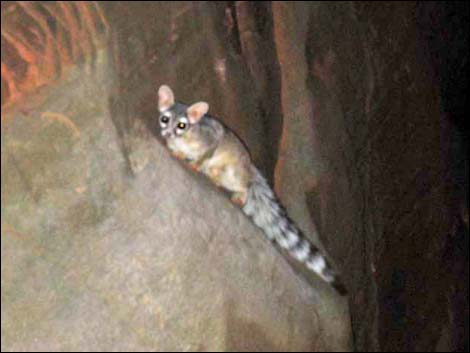 Ringtail: Our most-wanted mammal species |
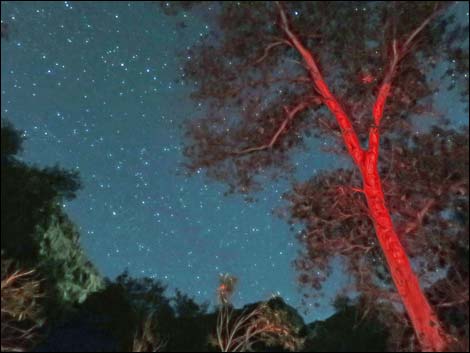 Night sky from Bright Angel Campground |
Note: All distances, elevations, and other facts are approximate.
![]() ; Last updated 151128
; Last updated 151128
| Grand Canyon | Postcards | Copyright, Conditions, Disclaimer | Home |